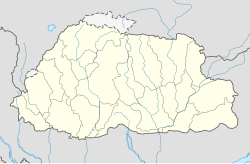Paro Taktsang
| Paro Taktsang | |
|---|---|

View of Paro Taktsang
|
|
|
|
|
| Coordinates | 27°29′30.88″N 89°21′48.56″E / 27.4919111°N 89.3634889°ECoordinates: 27°29′30.88″N 89°21′48.56″E / 27.4919111°N 89.3634889°E |
| Monastery information | |
| Location | Paro Valley, Paro District, Bhutan |
| Date renovated | 1958 and 2005 |
| Type | Tibetan Buddhist |
| Sect | Drukpa Kagyu and Nyingma |
| Dedicated to | Guru Padmasambhava |
| Architecture | Bhutanese |
Paro Taktsang (Dzongkha: སྤ་གྲོ་སྟག་ཚང་, also known as the Taktsang Palphug Monastery and the Tiger's Nest), is a prominent Himalayan Buddhist sacred site and the temple complex is located in the cliffside of the upper Paro valley in Bhutan.
A temple complex was first built in 1692, around the Taktsang Senge Samdup cave where Guru Padmasambhava is said to have meditated for three years, three months, three weeks, three days and three hours in the 8th century. Padmasambhava is credited with introducing Buddhism to Bhutan and is the tutelary deity of the country. Today, Paro Taktsang is the best known of the thirteen taktsang or "tiger lair" caves in which he meditated.
The temple devoted to Padmasambhava (also known as Gu-ru mTshan-brgyad Lhakhang, "the Temple of the Guru with Eight Names") is an elegant structure built around the cave in 1692 by Gyalse Tenzin Rabgye. It has become the cultural icon of Bhutan. A popular festival, known as the Tsechu, held in honor of Padmasambhava, is celebrated in the Paro valley sometime during March or April.
According to the legend related to this Taktsang (which in Tibetan language is spelt (stag tshang) which literally means "Tiger's lair", it is believed that Padmasambhava (Guru Rinpoche) flew to this location from Tibet on the back of a tigress from Khenpajong. This place was consecrated to tame the Tiger demon.
An alternative legend holds that a former wife of an emperor, known as Yeshe Tsogyal, willingly became a disciple of Guru Rinpoche (Padmasambahva) in Tibet. She transformed herself into a tigress and carried the Guru on her back from Tibet to the present location of the Taktsang in Bhutan. In one of the caves here, the Guru then performed meditation and emerged in eight incarnated forms (manifestations) and the place became holy. Subsequently, the place came to be known as the “Tiger's Nest”.
The popular legend of the Taktsang monastery is further embellished with the story of Tenzin Rabgye, who built the temple here in 1692. It has been mentioned by authors that the 8th century guru Padmasmabhava had reincarnated again in the form of Tenzin Rabgye. The corroborative proofs mooted are: that Tenzin Rabgye was seen (by his friends) concurrently inside and outside his cave; even a small quantity of food was adequate to feed all visitors; no one was injured during worship (in spite of the approach track to the monastery being dangerous and slippery); and the people of the Paro valley saw in the sky various animal forms and religious symbols including a shower of flowers that appeared and also vanished in the air without touching the earth.
...
Wikipedia

